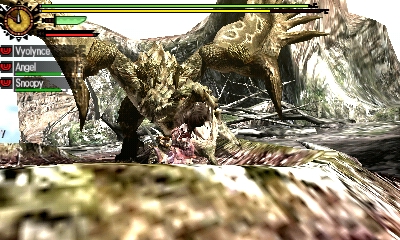
I might have mentioned Monster Hunter 3 Ultimate a few times over the last two years. You might also notice that we don’t have an actual review of MH3U here on Snackbar Games. The reason for this is that I bought it the same day I bought LEGO City: Undercover and that review took precedence; by the time I was able to play MH3U, it was too late for any review to be useful. I don’t have that problem this time, as indicated by the over 80 hours I’ve already put into Monster Hunter 4 Ultimate since picking it up — which officially makes it my second job if you do the math!
As an added bonus, I get to write this as a 850+ hour veteran of hunting monsters instead of the fresh-faced newbie I would have been writing the previous one. Although this is something of a shame, since MH4U might just be the most welcoming edition in the series, the beneficiary of ten years’ worth of feedback and refinement. An opening introductory mission walks you through some universal basics without needing to worry about which of the 14 weapons (including two brand-new ones) you want to start using, optional tutorial quests are provided for each individual weapon versus an actual opponent (well… a Great Jaggi, anyway), and new players can choose to receive additional help messages during quests to point out nuances that experienced players already know.
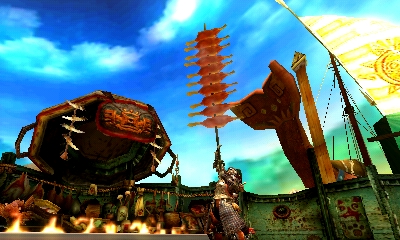
Which isn’t to say that MH4U isn’t without any new tricks to keep returning fans on their toes. The most prominent new addition to the series is verticality. Previous games have always taken place on flat terrain, with the exception of underwater fights in Tri/3U (which do not return this time and are largely not missed). Now there are different elevations scattered all over the place, making the landscapes feel more real and offering several tactical advantages as well, like jump attacks.
Every weapon (even guns/bows) can execute a special attack after jumping off a ledge or other high elevation. If such an attack connects, there is a chance that the hunter will then mount the monster rodeo-style. Of course, the monster isn’t going to sit there idly while you poke it in the kidneys, resulting in a minigame that alternates between stabbing away and holding on for dear life as the monster roars and thrashes. Succeed and you will score both massive damage and a knockdown; fail and you get bucked off, taking a bunch of damage yourself.
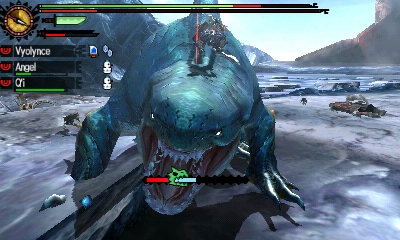
Other refinements are mostly found in the offline solo mode, which has been greatly expanded. Your hunter is part of a Caravan that ventures between different towns and takes care of giant monster-related problems of the locals. While you bring your own blacksmith, cook, merchant (mostly a replacement for the item-duplicating farm system of previous titles) and Guildmarm with you, each town has its own unique service so you will be making liberal use of the quick-travel map. It’s mostly a nice change of scenery instead of revisiting the same town layout for hundreds of quests, but at least it provides an in-game excuse for why you visit different hunting grounds as you progress.
Of course, just because you are playing solo doesn’t mean you’re alone. Sentient felyne (cat) companions, now called palicos, make their return from pre-Tri editions. Your main palico is actually part of character creation and will be by your side for every quest. Subsequent wild palicos can be recruited once you reach a certain point in the story, each bringing its own special set of skills. You will also eventually be able to craft armor and weapons for them, giving you more customization options than the Shakalakas of the last generation.
Other throwbacks to previous MH titles include a bunch of monsters who were absent last generation. Some of these are confined to expeditions, randomly-generated mini-quests that replace free hunts, but not all. Unfortunately several of these monsters can be a little boring, both in design and in combat. This is especially upsetting when compared to some of the awesome creatures who aren’t returning from 3U. The good news is that the brand-new monsters are all excellent, with some truly inspired designs, and even the old dogs have learned some new tricks so there are still surprises to be found.
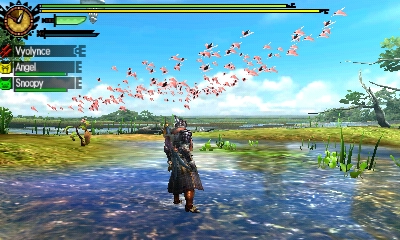
What hasn’t changed is the tried-and-true gameplay of “slay, carve, forge, repeat”. The endless cycle of needing to make new equipment out of parts of old monsters so you can be strong enough to take on new monsters to get new equipment is still one of the purest Skinner-box drives outside of freemium mobile games. Thankfully this is backed up by some truly awesome fights against epic creatures, battles that would be “boss-quality” in a more traditional action or RPG title.
Making the action even more rewarding is the fact that when you improve, it is because your actual skills have improved and not because some numbers on a virtual character sheet went up after an arbitrary period of time (or experience points). This includes hit points, by the way. You have the exact same amount of HP at the “end” of the game as you do at the very beginning. The only difference is how hard (and how often) you get hit and how well your armor protects you from those hits. And as always, you have no idea how much HP the monsters have, but as you gain experience you will be able to recognize the signs of fatigue as you wear them down.
While personal improvement is addicting, one of the best thrills of Monster Hunter comes when you team up with some friends and collectively take down a bunch of dragons, beasts, bugs or whatever. MH4U supports both online and local multiplayer, an improvement over 3U, the 3DS version of which only supported local wireless.
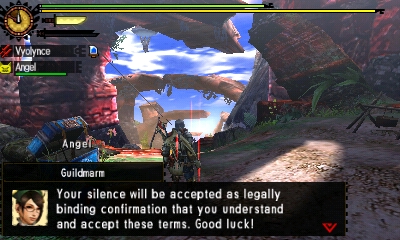
Online functionality comes at the cost of a Wii U version, and a few of the creature comforts that system’s added power offered. Chatting during a hunt is now restricted only to custom pre-set shout-outs, including a few that trigger automatically when certain game events happen, like mounting a monster or being paralyzed. More free-form keyboard chat is available in the inter-quest Gathering Hall, but even then you are confined to character limits that make efficient communication awkward. Completely lost is the ability to use voice chat; I would recommend that you look to a third-party service like Skype if that’s how you want to roll.
On the plus side, you can now access your Friend List at all times and can jump into one of their Gathering Halls at a moment’s notice. You can even set a four-digit password to keep strangers out of your room, but allow your friends to enter without actually needing it if you wish. Pick-up games are also possible if you don’t mind a slightly limited search function that only ever returns 20 results. But at least now you will never be unable to enter a room because the specific “world” is full. That happened to me in 3U more often than you might suspect.
However you play MH4U, it will threaten to steal untold hundreds of hours from your life if you let it. A demo is available in the eShop if you haven’t already tried it, which definitely has its shortcomings but is a decent introduction. Monster Hunter is very much a love-it-or-hate-it experience. If it is “for” you then it will sink its hooks in deep, but if it isn’t you will probably know right away.
Pros: potentially bottomless replay value, action-heavy combat enhanced by new elevation tactics
Cons: Online chat very limited, some “throwback” monsters probably should have stayed retired



















